Neue Photographische Gesellschaft (NPG) was the first and for years the world’s biggest factory for real photographic bromide postcards, which were printed ‘by the kilometre’. The founder and driving force was Arthur Schwarz (1862-1944), who travelled various countries, established contacts and gained knowledge.
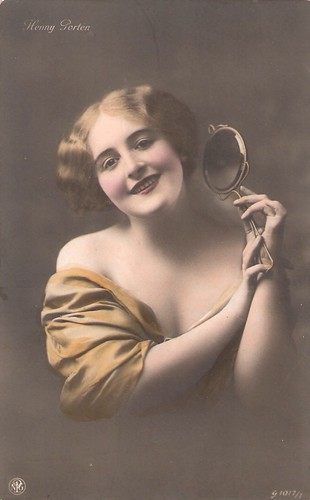
Henny Porten. German postcard by NPG (Neue Photographische Gesellschaft), no. G 1017/1.
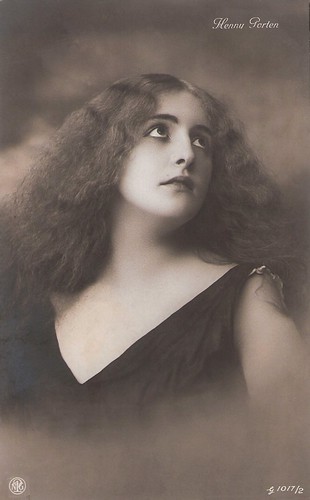
Henny Porten. German postcard by NPG, no. G 1017/2.
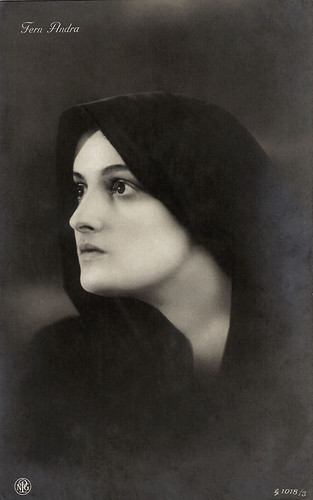
Fern Andra. German postcard by NPG, no. G 1018/3.
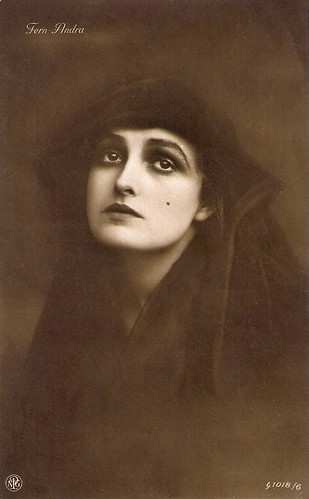
Fern Andra. German postcard by NPG, no. 1018/6.
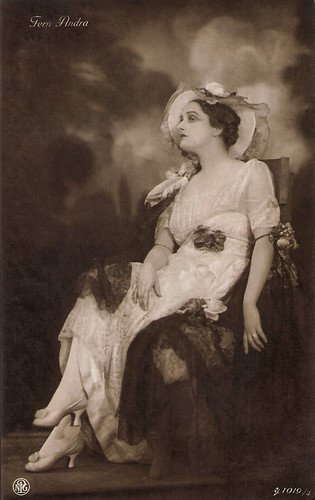
Fern Andra. German postcard by NPG, no. G 1019/4.
The New Photographic Society was a member organisation of photographers founded by Arthur Schwarz. He founded the NPG in July 1894 in Berlin-Schöneberg and the 35 members turned the group into a Limited Corporation (in German: AG).
The members published many real photo postcards and stereo-views, and they manufactured photo paper as well. The majority of the offered cards were bromide real photo cards, the others done by (copper) gravure process.
The NPG developed the use of photosensitive bromide silver paper in rotation. They were the first company who used photographic paper in roll form, thus simplifying the mass production of photographs. The NPG was called the inventor of the ‘km photography’.
Arthur Schwarz travelled to 60 cities in 75 days, in Canada, Mexico, Russia, Greece, Italy, France, etc. In these cities he established contacts and gained experience and knowledge. These trips were the basis for the establishment of subsidiaries in 1890 in London and 1892 in New York.
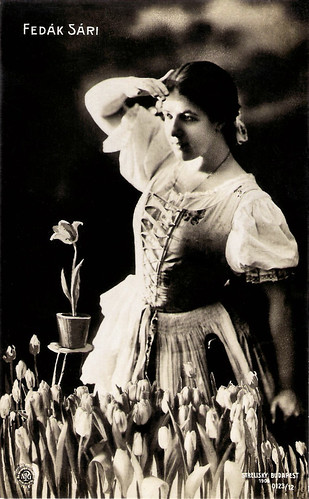
Sári Fedák. Hungarian postcard by NPG, no. 0123/12, 1906. Photo: Strelisky, Budapest.
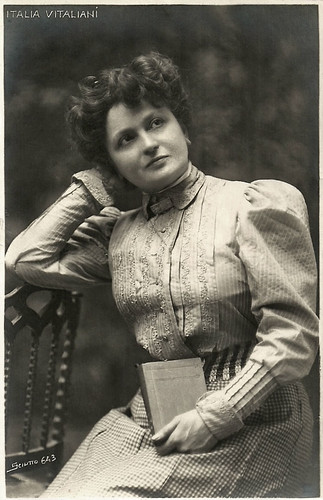
Italia Vitaliana. Italian postcard by NPG, no. 643. Photo: Sciutto. Gigi Sciutto was a famous Genovese photographer in the early 1900s. He supposedly shot the first film footage on Genova around 1897.
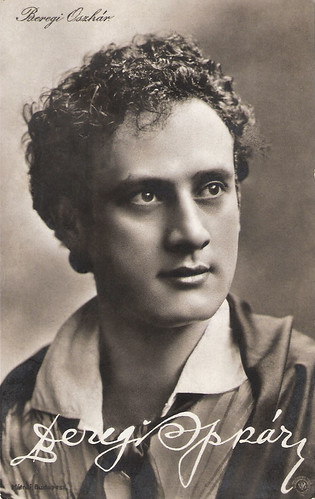
Oscar Beregi Sr. Hungarian postcard by NPG. Photo: Mátrai, Budapest.
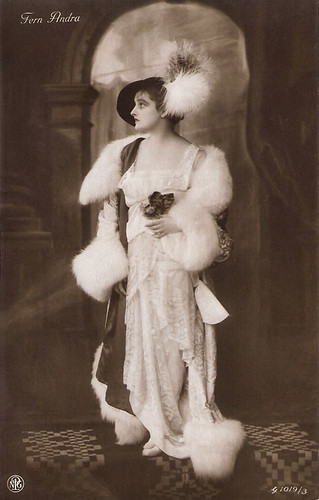
Fern Andra. German postcard by NPG, no. G 1019/3.

Henny Porten. German postcard by NPG, no. 794/5. Sent by mail in the Netherlands in 1921.
Backbone of the NPG success were machines used for photographic paper and printing constructed after US patents but improved. The machines automatically operated exposure and accelerated the process and solved the photo production from having to use glass plates. In one day more than 40,000 postcards could be produced. The NPG machines were built to last and some were in use for over 60 years.
Thanks to the various NPG patents registered between 1895-97 for many countries, Arthur Schwarz was in the position to minimize competition. In 1904 she had 650 employees, a few years later circa 1,200. NPG had branches and associated partner companies in London, New York, Paris, Vienna, Brussels, Milano etc.
They also printed real photo cards for other companies such as Rotograph and became the largest manufacturer of bromide postcards in the world. As demand for postcards grew they started publishing artist signed cards as tinted halftones.
NPG played a leading role, not only as photographic printer but also as publisher of thousands of postcards, stereo cards etc. Subjects for the postcards were the Kaiser and the Hohenzollern family, militaries, sculptures, and soon also actors. The first German film stars, like Henny Porten and Fern Andra, became popular subjects.

Lisa Weise. German postcard by NPG, no. 516. Photo: Lili Baruch, Berlin. Collection: Didier Hanson.

Alwin Neuss. German postcard by NPG, no. 823. Photo: Becker & Maass, Berlin.
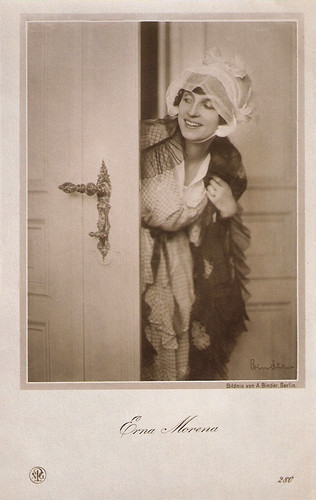
Erna Morena. German postcard by NPG, no. 280. Photo: Alex Binder, Berlin.

Theodor Loos. German postcard by NPG, no. 894. Photo: Käthe Hirschfeld, Berlin.
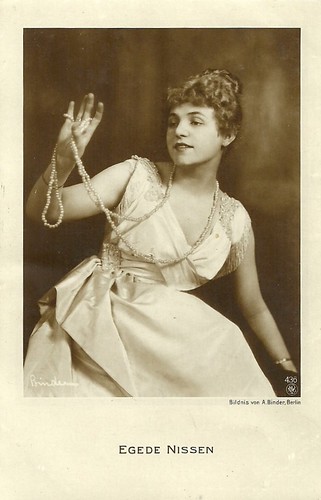
Aud Egede Nissen. German postcard by NPG, no. 436. Photo: Alex Binder, Berlin.
The NPG was characterized by a social enterprise culture. For the employee was a company health insurance set up, granted to employees in addition to free medical treatment and medicine sick pay. In addition, there was a life insurance policy on the basis of a bonus system and Christmas bonuses for all employees, which amounted to a total of 20,000 marks in 1903.
A fire brigade of 37 men provided security at the factory and the company's own casino supplied in its dining room 36 meters long and 14 meters wide, the employees with food and drinks at cost price. The female staff was granted a free lunch. A reading room with newspapers and a stage for performances and presentations provided for the welfare of the employees.
Between 1910 and 1912, the basics of color photography were developed by the chemist Rudolf Fischer and his collaborator Hans Sigrist in the laboratories of the NPG. However, the colour photography process was never really ready for the market.
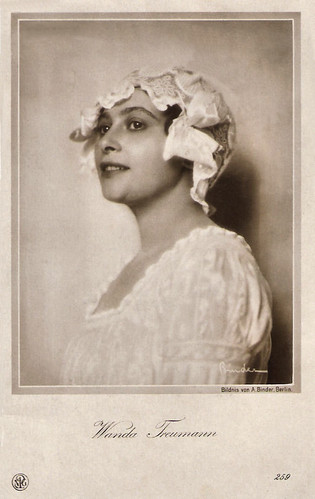
Wanda Treumann. German postcard by NPG, no. 259. Photo: Alex Binder, Berlin.

Oscar Beregi Sr. German postcard by NPG, no. 1275 Photo: Angelo, Budapest, 1918.
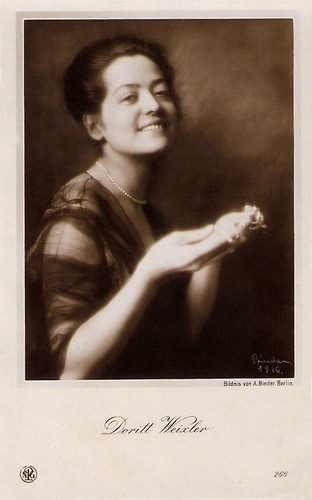
Dorrit Weixler. German postcard by NPG, no. 266. Photo: Alex Binder, 1916.

Nils Chrisander. German postcard by NPG, no. 427. Photo: Alex Binder.
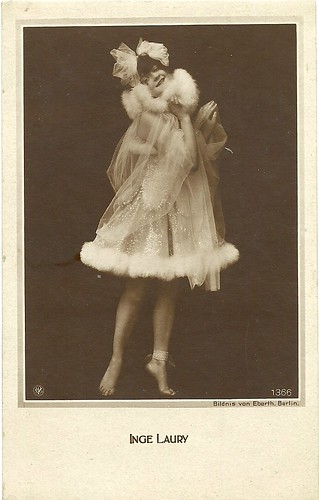
Inge Laury. German postcard by NPG, no. 1366. Photo: Eberth, Berlin. Collection: Didier Hanson.
Arthur Schwarz had to leave his company in 1913. In 1921 a new NPG GmbH (Ltd) company was set up. Mimosa AG Dresden had bought shares of NPG already in 1920. The decline of the postcard boom, WW1, but also some mismanagement and the failed introduction of the colour photography process never really ready for the market, meant the end of the old company.
Local competitor E.A. Schwerdtfeger AG took over the NPG trademark and postcard department, who continued producing their cards until the Second World War.
The newly formed NPG Ltd. was in business until 1948. It stayed for many years in Berlin, and then moved to Dresden.
Neue Photographische Gesellschaft (NPG) had a variety of logo’s registered. The regular NPG logo is around in several designs and in all the film star postcards in this post.
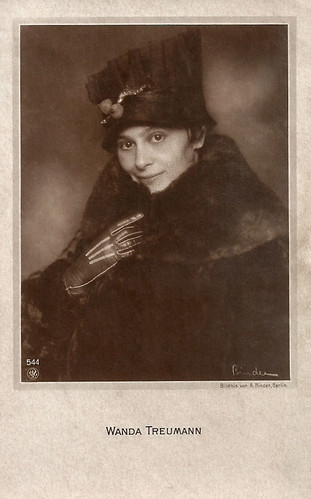
Wanda Treumann. German postcard by NPG, no. 544. Photo: Alex Binder, Berlin.
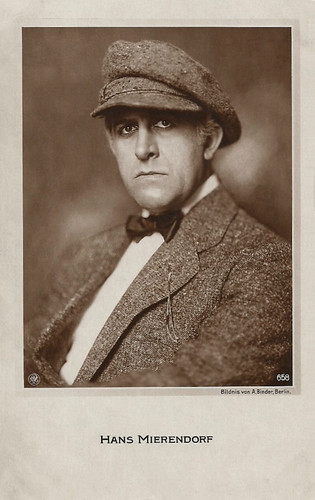
Hans Mierendorff. German postcard by NPG, no. 658. Photo: Alex Binder, Berlin.
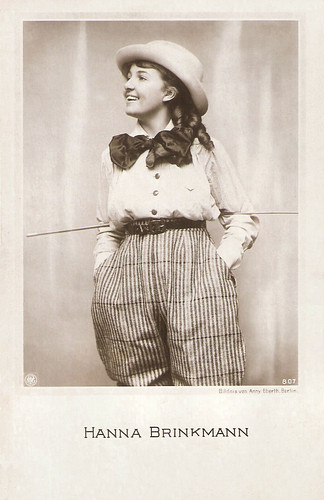
Hanne Brinkmann. German postcard by NPG, no. 807. Photo: Anny Eberth, Berlin.
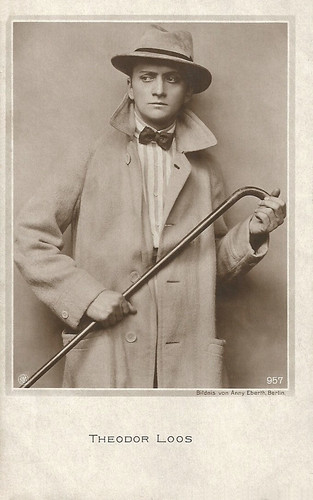
Theodoor Loos. German postcard by NPG, no. 957. Photo: Anny Eberth, Berlin.
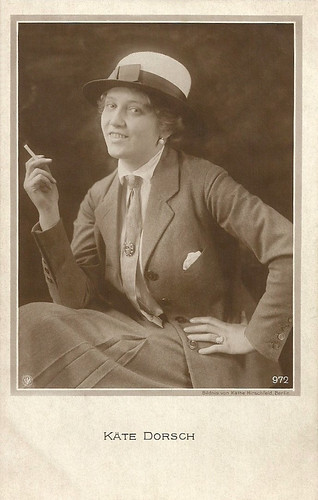
Käthe Dorsch. German postcard by NPG (Neue Photographische Gesellschaft), no. 972. Photo: Käthe Hirschfeld, Berlin.
This was the eighth post in a series on film star postcard publishers. Next week: Kwatta. For earlier posts, see the links at right under the caption 'The Publishers'.
Sources: Wolfgang Holtz (Neue Photografische Gesellschaft Steglitz – German), The Postcard Album, Metropostcard and Wikipedia (German).

Henny Porten. German postcard by NPG (Neue Photographische Gesellschaft), no. G 1017/1.

Henny Porten. German postcard by NPG, no. G 1017/2.

Fern Andra. German postcard by NPG, no. G 1018/3.

Fern Andra. German postcard by NPG, no. 1018/6.

Fern Andra. German postcard by NPG, no. G 1019/4.
More than 40,000 postcards a day
The New Photographic Society was a member organisation of photographers founded by Arthur Schwarz. He founded the NPG in July 1894 in Berlin-Schöneberg and the 35 members turned the group into a Limited Corporation (in German: AG).
The members published many real photo postcards and stereo-views, and they manufactured photo paper as well. The majority of the offered cards were bromide real photo cards, the others done by (copper) gravure process.
The NPG developed the use of photosensitive bromide silver paper in rotation. They were the first company who used photographic paper in roll form, thus simplifying the mass production of photographs. The NPG was called the inventor of the ‘km photography’.
Arthur Schwarz travelled to 60 cities in 75 days, in Canada, Mexico, Russia, Greece, Italy, France, etc. In these cities he established contacts and gained experience and knowledge. These trips were the basis for the establishment of subsidiaries in 1890 in London and 1892 in New York.

Sári Fedák. Hungarian postcard by NPG, no. 0123/12, 1906. Photo: Strelisky, Budapest.

Italia Vitaliana. Italian postcard by NPG, no. 643. Photo: Sciutto. Gigi Sciutto was a famous Genovese photographer in the early 1900s. He supposedly shot the first film footage on Genova around 1897.

Oscar Beregi Sr. Hungarian postcard by NPG. Photo: Mátrai, Budapest.

Fern Andra. German postcard by NPG, no. G 1019/3.

Henny Porten. German postcard by NPG, no. 794/5. Sent by mail in the Netherlands in 1921.
Minimizing the competition
Backbone of the NPG success were machines used for photographic paper and printing constructed after US patents but improved. The machines automatically operated exposure and accelerated the process and solved the photo production from having to use glass plates. In one day more than 40,000 postcards could be produced. The NPG machines were built to last and some were in use for over 60 years.
Thanks to the various NPG patents registered between 1895-97 for many countries, Arthur Schwarz was in the position to minimize competition. In 1904 she had 650 employees, a few years later circa 1,200. NPG had branches and associated partner companies in London, New York, Paris, Vienna, Brussels, Milano etc.
They also printed real photo cards for other companies such as Rotograph and became the largest manufacturer of bromide postcards in the world. As demand for postcards grew they started publishing artist signed cards as tinted halftones.
NPG played a leading role, not only as photographic printer but also as publisher of thousands of postcards, stereo cards etc. Subjects for the postcards were the Kaiser and the Hohenzollern family, militaries, sculptures, and soon also actors. The first German film stars, like Henny Porten and Fern Andra, became popular subjects.

Lisa Weise. German postcard by NPG, no. 516. Photo: Lili Baruch, Berlin. Collection: Didier Hanson.

Alwin Neuss. German postcard by NPG, no. 823. Photo: Becker & Maass, Berlin.

Erna Morena. German postcard by NPG, no. 280. Photo: Alex Binder, Berlin.

Theodor Loos. German postcard by NPG, no. 894. Photo: Käthe Hirschfeld, Berlin.

Aud Egede Nissen. German postcard by NPG, no. 436. Photo: Alex Binder, Berlin.
Social enterprise
The NPG was characterized by a social enterprise culture. For the employee was a company health insurance set up, granted to employees in addition to free medical treatment and medicine sick pay. In addition, there was a life insurance policy on the basis of a bonus system and Christmas bonuses for all employees, which amounted to a total of 20,000 marks in 1903.
A fire brigade of 37 men provided security at the factory and the company's own casino supplied in its dining room 36 meters long and 14 meters wide, the employees with food and drinks at cost price. The female staff was granted a free lunch. A reading room with newspapers and a stage for performances and presentations provided for the welfare of the employees.
Between 1910 and 1912, the basics of color photography were developed by the chemist Rudolf Fischer and his collaborator Hans Sigrist in the laboratories of the NPG. However, the colour photography process was never really ready for the market.

Wanda Treumann. German postcard by NPG, no. 259. Photo: Alex Binder, Berlin.

Oscar Beregi Sr. German postcard by NPG, no. 1275 Photo: Angelo, Budapest, 1918.

Dorrit Weixler. German postcard by NPG, no. 266. Photo: Alex Binder, 1916.

Nils Chrisander. German postcard by NPG, no. 427. Photo: Alex Binder.

Inge Laury. German postcard by NPG, no. 1366. Photo: Eberth, Berlin. Collection: Didier Hanson.
Colour photography process
Arthur Schwarz had to leave his company in 1913. In 1921 a new NPG GmbH (Ltd) company was set up. Mimosa AG Dresden had bought shares of NPG already in 1920. The decline of the postcard boom, WW1, but also some mismanagement and the failed introduction of the colour photography process never really ready for the market, meant the end of the old company.
Local competitor E.A. Schwerdtfeger AG took over the NPG trademark and postcard department, who continued producing their cards until the Second World War.
The newly formed NPG Ltd. was in business until 1948. It stayed for many years in Berlin, and then moved to Dresden.
Neue Photographische Gesellschaft (NPG) had a variety of logo’s registered. The regular NPG logo is around in several designs and in all the film star postcards in this post.

Wanda Treumann. German postcard by NPG, no. 544. Photo: Alex Binder, Berlin.

Hans Mierendorff. German postcard by NPG, no. 658. Photo: Alex Binder, Berlin.

Hanne Brinkmann. German postcard by NPG, no. 807. Photo: Anny Eberth, Berlin.

Theodoor Loos. German postcard by NPG, no. 957. Photo: Anny Eberth, Berlin.

Käthe Dorsch. German postcard by NPG (Neue Photographische Gesellschaft), no. 972. Photo: Käthe Hirschfeld, Berlin.
This was the eighth post in a series on film star postcard publishers. Next week: Kwatta. For earlier posts, see the links at right under the caption 'The Publishers'.
Sources: Wolfgang Holtz (Neue Photografische Gesellschaft Steglitz – German), The Postcard Album, Metropostcard and Wikipedia (German).
No comments:
Post a Comment